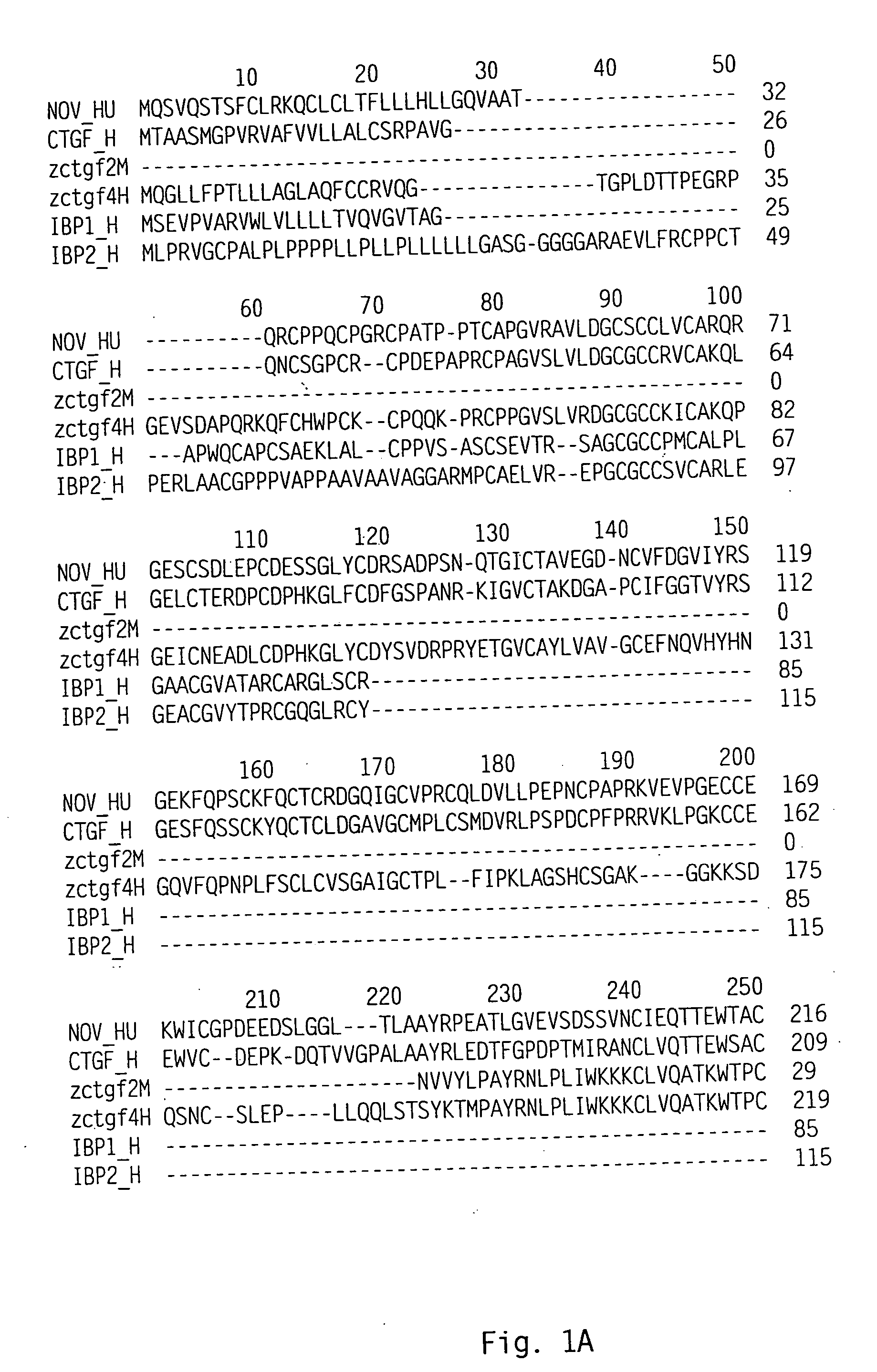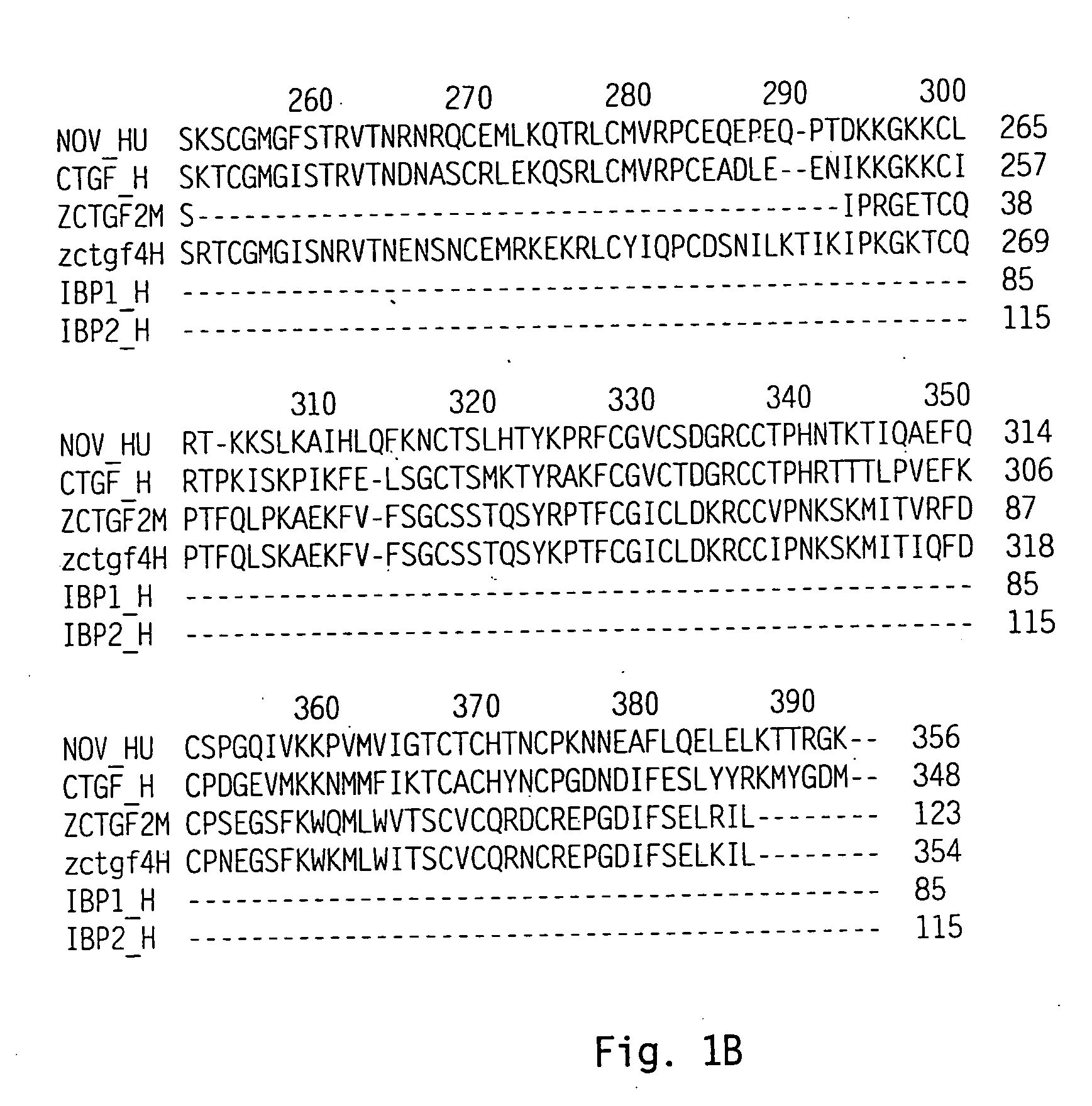Connective tissue growth factor homologs
a technology of connective tissue and growth factor, which is applied in the direction of immunoglobulins, peptide/protein ingredients, peptides/protein ingredients, etc., can solve the problem of limited current therapy for ligament repair
- Summary
- Abstract
- Description
- Claims
- Application Information
AI Technical Summary
Problems solved by technology
Method used
Image
Examples
example 1
[0161] Scanning of a translated DNA database using the CTGF family motifs as a query resulted in identification of an EST sequence found to have some homology to the connective tissue growth factor family.
[0162] Plasmid DNA was isolated from a clone corresponding to the EST, which had been designated zCTGF4, and was analyzed for polynucleotide sequence. Upon alignment of the zCTGF4 cDNA and CTGF family, it was revealed that the clone contained a truncated cDNA sequence with an intron at the 5′ end of the sequence.
[0163] Based on the tissue distribution from Northern blot analysis (see Example 2), a cDNA library was constructed from human testis, and used to screen for a full length clone. The library was calculated to contain approximately 106 clones. The master plate containing 80 pools (each pool representing 12 pools of 1.25×104 clones) was screened using PCR to determine whether zCTFG4 cDNA was present. Reactions were set up using: 1 μl of each pool, 20 pmoles each of oligonuc...
example 2
[0167] Northern analyses were performed using Human Multiple Tissue Blots I, II and III from Clontech (Palo Alto, Calif.). A probe was generated from a gel purified PCR product made from ZC14, 883 (SEQ ID NO: 7) and ZC14, 882 (SEQ ID NO: 6) as primers and zCTGF4 as template, that had been radioactively labeled with REDIPRIME™ DNA labeling kit (Amersham, Arlington Heights, Ill.) according to the manufacturer's suggestion. The probe was purified using a NUCTRAP push column (Stratagene). EXPRESSHYB™ (Clontech) solution was used for prehybridization and as a hybridizing solution for the Northern blots. Hybridization took place overnight at 65° C., and the blots were then washed in 2×SSC and 0.05% SDS at RT, followed by a wash in 0.1×SSC and 0.1% SDS at 50° C. One major transcript was observed at size of 1.4 kb. Signals were present in testis, bone marrow, trachea, kidney, liver, stomach, small intestine, ovary, placenta, prostate and spinal cord. The expression of zCTGF4 was also examin...
example 3
[0168] zCTGF4 was mapped to chromosome 6 using the commercially available “GeneBridge 4 Radiation Hybrid Panel” (Research Genetics, Inc., Huntsville, Ala.). The GeneBridge 4 Radiation Hybrid Panel contained DNAs from each of 93 radiation hybrid clones, plus two control DNAs (the HFL donor and the A23 recipient). A publicly available WWW server (http: / / www-genome.wi.mit.edu / cgi-bin / contig / rhmapper.pl) allowed mapping relative to the Whitehead Institute / MIT Center for Genome Research's radiation hybrid map of the human genome (the “WICGR” radiation hybrid map) which was constructed with the GeneBridge 4 Radiation Hybrid Panel.
[0169] For the mapping of zCTGF4 with the “GeneBridge 4 RH Panel”, 20 μl reactions were set up in a 96-well microtiter plate (Stratagene, La Jolla, Calif.), and used in a “RoboCycler Gradient 96” thermal cycler (Stratagene). Each of the 95 PCR reactions consisted of 2 μl 10× KlenTaq PCR reaction buffer (CLONTECH Laboratories, Inc., Palo Alto, Calif.), 1.6 μl dNT...
PUM
| Property | Measurement | Unit |
|---|---|---|
| Fraction | aaaaa | aaaaa |
| Fraction | aaaaa | aaaaa |
| Fraction | aaaaa | aaaaa |
Abstract
Description
Claims
Application Information
 Login to View More
Login to View More - R&D
- Intellectual Property
- Life Sciences
- Materials
- Tech Scout
- Unparalleled Data Quality
- Higher Quality Content
- 60% Fewer Hallucinations
Browse by: Latest US Patents, China's latest patents, Technical Efficacy Thesaurus, Application Domain, Technology Topic, Popular Technical Reports.
© 2025 PatSnap. All rights reserved.Legal|Privacy policy|Modern Slavery Act Transparency Statement|Sitemap|About US| Contact US: help@patsnap.com



